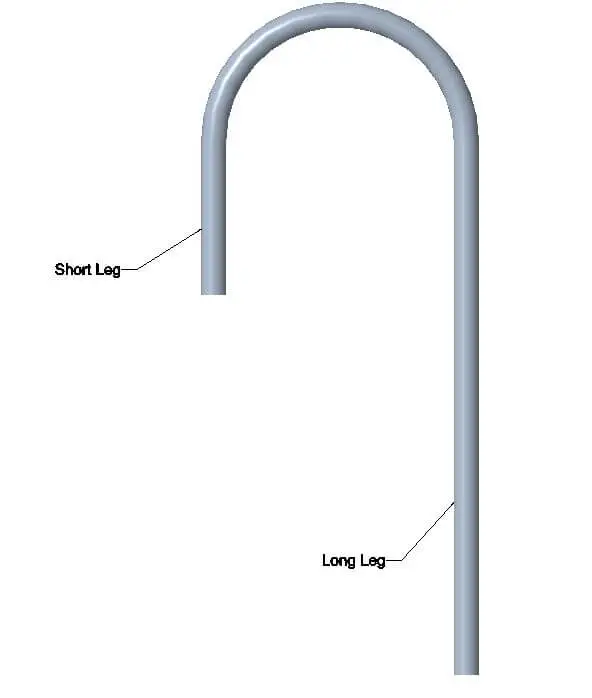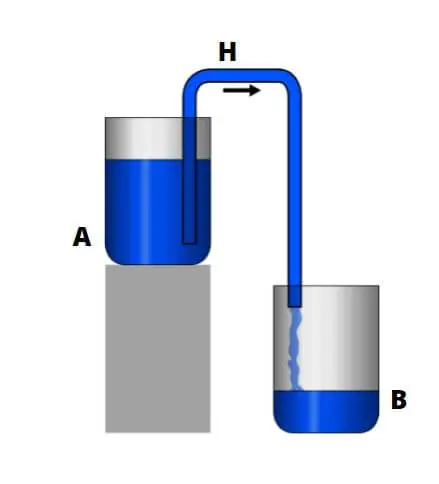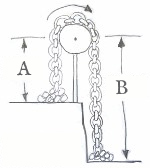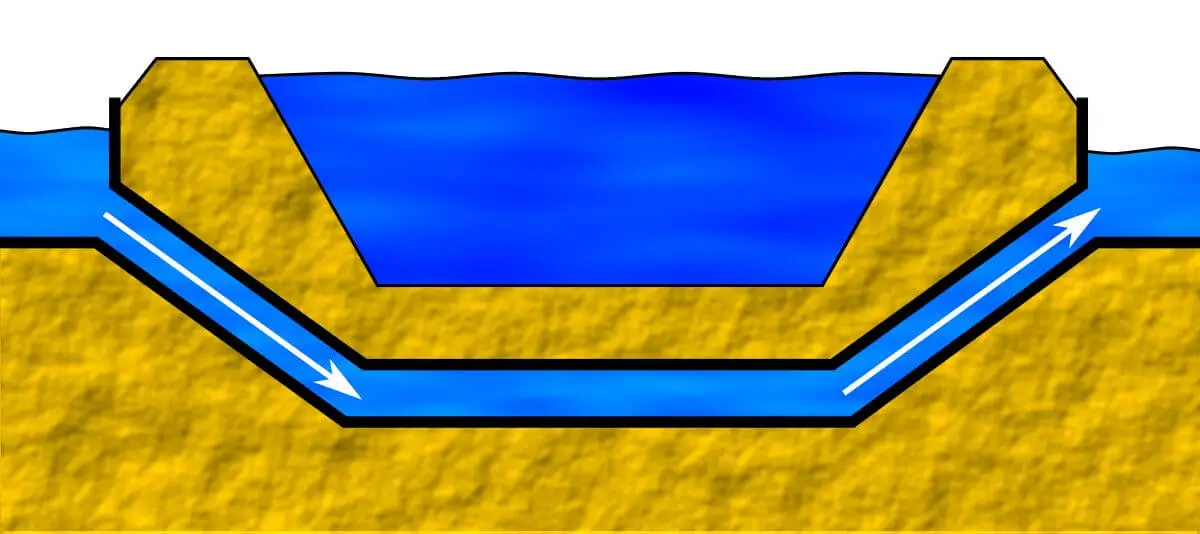The Siphon or Syphon principle is a widely used mechanism in Fluid Mechanics to transfer fluid from a higher elevation container to a lower elevation container. Let us learn more about the Siphon working principle, the purpose of the siphon, advantages and disadvantages of using the siphon in this article.
Siphon Definition
The siphon is an inverted U shape pipe. It has two ends, one is the long end, and the other is the short end. The long end is submerged into the container at the lower elevation. The short end is dipped into the container that is at a higher elevation.

Purpose of Siphon
- To transfer liquid from a higher elevation to a lower elevation without any external force or power.
- To get a continuous flow of liquids.
Siphon Working Principle
We already learned that Siphon could transfer fluid from a higher elevation to a lower elevation. Many of you may think that water can easily flow from a higher to a lower elevation due to gravity. Then what’s the big deal in Siphon?
To explain Siphon Principle, lets focus on the below image.

As you can see, the liquid flows from a higher elevation to a lower elevation, but there is a barrier ( Container Wall) between the flow.
The liquid must climb a certain height against gravity before it flows down to the container kept at a lower elevation. How does the liquid climb against gravity without any external force? That’s the beauty of the Siphon principle.
Here are the three different theories to explain the Siphon principle.
- Atmospheric pressure
- Cohesive Force
- Gravitational Potential Difference
Atmospheric Pressure
Liquid always flows from a high-pressure zone to a low-pressure zone. Correct? The same phenomenon applies to the Siphon too. To explain this, let us take one example.
In the below image,

A= Reservoir at a higher elevation
B= Reservoir at lower elevation
H= Highest point of the Siphon
Do you remember that when we climb a steep hill, blood comes out of our noses? This is due to the low air pressure. The more you go up, the lower the air pressure, and due to the pressure difference, blood comes out.
Now coming to this Siphon working principle, the pressure will be low at point H, which can also be below the atmospheric pressure. Due to this pressure difference between reservoir A and B, liquid climbs to a point H, and from there, it flows to the lower reservoir due to gravity.
To create the pressure difference, we can also suck air from the pipe end that is submerged into the lower elevated container or we can use any external force.
Do you know that the maximum siphon height for water at standard atmospheric pressure is 10 meters? If the siphon tube’s low-end length ( Point H in the image) is more than 10 meters, the siphon principle won’t work.
Cohesive Force
Do you know that Siphon works in a vacuum also? This is due to the cohesive force between the molecules of the liquid. The more cohesive force, the better will be the liquid flow.
However, for the initial flow of liquid, you need to create the pressure difference. After that, the flow can continue due to the cohesive force.

This principle is also called the chain model, as the heavier chain in the long tube always pulls the lighter chain in the short tube to keep the liquid flow continuing.
Gravitational Potential Difference
Gravity plays a big role in Siphon. The potential energy difference at different ends of the tube causes the flow of liquid. Of course, in this case, also, you need to create the initial pressure difference manually or using an alternate method.
So the summary is that we need to have all mentioned factors into consideration for a siphon to work property. We need the atmospheric pressure difference for the initial start of the flow, and then we need the cohesive force and the gravitational potential difference to keep the flow continuing.
Siphon And Bernoulli’s Theorem
The Bernoulli’s theorem applies to Siphon also which states that the pressure, potential energy, and kinetic energy remain constant of a fluid flow inside a tube.
(p/ρg)+ (v2/2g)+z= Constant
p = Pressure difference
v= Velocity of the fluid at the lower elevation
ρ = Density of the fluid
g = Gravitational constant
z= Elevation
We can use this theorem to calculate pressure, velocity and the elevation for a siphon tube.
You may also like to read: What is a venturimeter: Venturimeter working principle
What is Inverted Siphon?
As the name suggests, an inverted siphon is a U-shaped pipe that uses pressure instead of gravity to flow liquids. Inverted siphons are commonly used for under-the-road water flow.

Application Of Siphon
- To transfer fluid from one reservoir to another reservoir without any external force
- To empty a reservoir when there is no outlet
- To empty a channel when there is no outlet.
- In Water purification plants
- To drain sewage waters
- In irrigation systems to supply controlled level of water
Advantages Of Siphon
- No external pressure is required
- Constant liquid flow can be achieved
- No loss of liquid during transfer
- A cheap and effective way of transferring liquid
Disadvantages Of Siphon
- The very slow liquid transfer process
- Not suitable for production plants
Conclusion: Siphon Principle
I hope that you have enough insights now about Siphon. But if you still have any questions or queries, please don’t hesitate to write in the comment section, and I will be happy to help.
Frequently Asked Question (FAQ) on Siphon
What is Siphon?
Siphon is an inverted U tube used to transfer liquid from a higher elevation to a lower elevation without using any external force.
How Does Siphon Transfers Liquid?
Siphons use the pressure difference at both ends of the tube, cohesive forces between liquid molecules and the gravitational potential difference to transfer the fluid.
Does Siphon Work in Vacuum?
Yes, it does. But the cohesive force should be more between liquid molecules.



